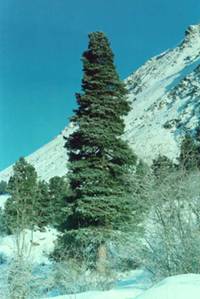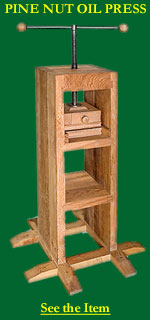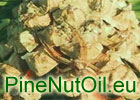Siberian Cedars
PineNutOil.org
 The types of cedar include the European cedar (Pinus cembra L.), the Siberian cedar (Pinus sibirica (Rupr.) Mayr.), the Korean cedar, or Manchurian cedar (Pinus koraiensis Sieb. et Zucc.), and the dwarf cedar tree (Pinus pumila (Pall.) Rgl.). The Siberian cedar has entered popular speech under the name "Siberian cedar." Following this, other pines also received similar names: European cedar and Korean cedar.
The types of cedar include the European cedar (Pinus cembra L.), the Siberian cedar (Pinus sibirica (Rupr.) Mayr.), the Korean cedar, or Manchurian cedar (Pinus koraiensis Sieb. et Zucc.), and the dwarf cedar tree (Pinus pumila (Pall.) Rgl.). The Siberian cedar has entered popular speech under the name "Siberian cedar." Following this, other pines also received similar names: European cedar and Korean cedar.
A general characteristic of all pines is their heightened attraction for moisture. With significant moisture, the woody pines form a plantation mixed with fir or spruce, while in conditions of a surplus supply of moisture, they yield in competition to fir. In areas with irregular moisture conditions, the Siberian cedar grows in a mixture with the common cedar on mechanically lighter soils or even under its canopy, and also with the Siberian larch (in especially cold soils), and the Korean cedar - as part of wide-leafed forests. With the increase in dryness of the air and the continental nature of the climate, the Siberian cedar yields its position to the larch and spruce, while the Korean cedar yields to the Sayan spruce and larch.
Over the larger part of its natural habitat, the dwarf cedar tree forms neat thickets. As a rule, it grows in the tree line. In the cold regions near the Okhotsk Sea and Eastern Baikal Region, it emerges onto the coast. In better growing conditions, it forms a lower layer in larch and boreal forests.
Cedar pines have essential differences among themselves with respect to cold resistance and also with respect to the optimal temperatures required for vegetation. This is related to the different regime of heat conditions in the boundaries of the natural habitat of each variety, conditions to which they have adapted in the process of a lengthy evolution. The European cedar grows in conditions of a comparatively mild continental climate with a slightly negative air temperature in the winter period (-8.8 C).
The Korean cedar grows in continental climate conditions with a low air temperature in the winter and a high air temperature in the summer. For the Siberian cedar a higher resistance to cold is characteristic. However, the Siberian cedar does not tolerate cold soils, its northern and eastern borders correspond to the south-western boundary of the distribution of the permafrost.
In the area of the especially sharply continental climate of north-eastern Asia, which corresponds to the permafrost zone, of the pines, only the dwarf cedar tree grows. The average annual temperature of the air here reaches -14 C, while the average temperature in January reaches -40 C. The growth of the dwarf cedar tree in such severe climatic conditions is made possible by the ability of its branches to bend down to the ground and pass the winter beneath a thick layer of snow.
The Siberian cedar (Pinus sibirica) is a tree with a height of up to 40 metres, the diameter of its trunk reaches 1.5 to 2 metres. In young trees the crown is sharply tapered, in adult trees it is widely spreading, often polyconic. The arrangement of branches is whorled. The upper branches are chandelier-like, raised upward. The bark on young trunks and branches is ash-silver, with grayish brown transverse lenticels, later it is fissured and grey-brown. The needles are 5 to 12 cm in length, soft, trihedral in cross section, dark green with a dove-coloured coating; they are retained on the tree for 3 to 7 years. The male pollen-covered spikelets are located usually in the middle part of the crown; the female cones are found at the ends of the upper shoots of the tree, with two or three along the apical bud. Only the upper part of the crown with a length of 1 to 1.5 m (rarely up to 2m) bears fruit. The ripe cones are oval, with a length of 6 to 13 cm, and a width of 5 to 8 cm, light grayish brown, they have tightly closed scales with reinforced scutella; they contain 80 to 140 brown seeds with a length of 10 to 14 mm, and a width of 6 to 10 mm. The root system is of the tap type with extended lateral roots.
The dependence of ecological properties on the conditions of the environment is manifested in the cedar better than in other coniferous trees of Siberia. This is explained by the large surface area of the needles, the polymorphic nature of the root system, and several anatomical features, which increase its suitability for the wide range of conditions in which it grows.
This suitability most distinctly reveals itself with regard to the dampness and temperature of the soil. On the northern boundary of its distribution in a damp and cold climate, the Siberian cedar is sensitive to the frozen condition of the ground and occupies warmed slopes with dryer soils. On the contrary, in conditions of sufficient heat supply in the southern part of its natural habitat, the cedar selects colder and therefore better moistened places to live. In places with sufficient heat supply and optimal moisture (for example, in the Khamar-Daban mountain range), the cedar grows on all parts of the topography.
When growing in late thawing soils, the cedar forms a surface root system, but is not uprooted by wind because of this. In these conditions, its roots are very long and create a large area of support. A significant lengthening of roots in general is characteristic for woody and grassy plants that grow in cold soils. In addition, in these conditions the root systems of adjacent cedars grow together, which substantially increases their resistance to the wind.
In water-logged soils with a well developed mossy covering, the cedar quite often forms supplementary roots. It is surpassed in this suitability for water-logged soils only by the Gmelina larch.
The cedar's weak spot is its requirement for a high relative humidity of the air, especially in the winter period. In this respect it is similar to the Siberian fir, from which it substantially differs in other ecological properties. This requirement is caused by a very large surface area of the needles in the cedar and the fir. For this reason, the cedar cannot grow in places with a dry climate, which limits its spread to the forest-steppe.
It grows slowly, lives from 300 to 550 years, some trees live up to 800 years. In closed forest stands, it "blossoms" (in June) from 40 to 50 years, in thinned out stands, it "blossoms" from 13 to 15 years. The development of the generative organs and microspore genesis lasts for two years. The seeds ripen in the second year following the "blossoming," in August. When the germ is fully formed, the outer shell of the seed becomes dark, the cones dry out, their resin content becomes less, and in August and September a massive fall of cones is observed. In a harvest year, one large tree yields up to 1000 - 1500 cones. In nature, the Siberian cedar reproduces by seeds spread by the nutcracker, chipmunk, squirrel, sable, and other animals that feed on cedar nuts; in the cultivated state, it reproduces primarily by seedlings and saplings, economically valuable forms are reproduced using grafts. The Siberian cedar is a harshly continental climate species. In its maturity, it requires light. It grows in the most diverse soils, but prefers drained, deep sandy loam and loamy slightly podsolized soils. It has a poor tolerance for air polluted by smoke and being transplanted in the adult state. The wood is light, soft, pink-yellow, with an attractive texture, and aromatic. It is common in the mountains and flatlands of the north-eastern European portion of Russia, from the upper reaches of the Vychegda River throughout almost all western and eastern Siberia as an addition to spruce and other types of forests, or as pure forest stands. In the mountains, it goes up to the upper boundary of the forest. In peat bogs and mountainous forests we find the low-growing and partially creeping forms of the Siberian cedar (P. sibirica f. turfosa, P. sibirica f. coronans, P. sibirica f. humistrata), which differ from the valley type, and are regarded by some botanists as separate species.
In order to introduce the cedar more widely into cultivation, it is necessary to overcome the current impression of it as a slow growing species, to expand the area it is sown in nurseries, to cultivate this species more aggressively on fairly rich, drained, fresh loamy and sandy loam soils. The introduction of the cedar into plantations increases their productivity over their lifetime as well as their longevity.
As a cultivated plant in the European provinces of Russia, the cedar can be recommended both as an ornamental orchard species as well as a forest species. Cedar orchards close to villages may be used to obtain cedar nuts, as well as a wonderful place for relaxation. The introduction of the Siberian cedar into the plantations of green belts and group I forests will increase their recreational opportunities and water-protection properties. Since it bears nuts, the Siberian cedar promotes the increase in number and diversity of forest fauna.
The Siberian cedar belongs to the shade-tolerating species of trees. On a comparative scale, it tolerates shade less than the common spruce, but significantly exceeds the common cedar. However, tolerance of shade does not at all mean that this is a requirement of the Siberian cedar for shade. Its relationship to light is not the same at various ages. Shoots tolerate strong shade. But the greater the age and the older the plant, the more the requirement for light increases. Observations show that, at a young age, it is capable of tolerating negligible illumination, and in its natural state the young seedling may be found together with spruce and fir beneath the canopy of the upper layers of tree stands.
The Siberian cedar prefers loamy and sandy loam soils that are sufficiently moistened, but well drained and fertile. However, within the limits of its natural habitat, it is found in the most diverse types of soils and topographies of an area. M. E. Tkachenko cites data where the Siberian cedar has grown in dry sands and on rocky cliffs. The Academician P. S. Pallas wrote that this species of tree was growing in swamps and reached high into the mountains. Professor B. V. Grozdov noted the growth of the Siberian cedar in permafrost soils, where it forms supplementary roots.
The first cultivated Siberian cedars in the European part of Russia about which there is documentary information dates back to the second half of the XVI century, when the Tolgskaya cedar grove was laid out near Yaroslavl, 8 km from the city. This grove was located on the left bank of the Volga, 300 m from the shore, on the territory of the former Tolgskaya Monastery, which was constructed in 1314. Cedars began to be cultivated in the area around Moscow long ago. This species of tree drew attention to itself as far back as the XVII century in Moscow and its surroundings. These trees were planted in many princely estates. The Nikolo-Uryupino estate (Krasnogorskoe District), which still in the XVII century belonged to the princes of the Odoevsky family, deserves special attention. Siberian cedars in the Abramtsevo Park (Sergievo-Posadsky District) are of great interest. There are cedars in the Tarusovo Estate (Taldom District) in the Morozovka Estate (Solnechnogorsk District), in Leninsky District (in the Valtsevo Estate, in the village of Gorki), in Mytishchi District (Vinogradovo, Marfino Sanatorium), in Ruza District (Nikolskoe-Gagarino), in Khimki District (Vasilevskoe-Skurygino), in Podolsk District (Vorontsovo Estate, Ostafevo), in Serpukhov District (Pushchino-Vyazemskoe, Turov), and other places.
Cedar groves and individual trees are also found in St. Petersburg and its surroundings, in Vologda Oblast (village of Chargino, Gryazovets District), in Karelia (city of Sortavala), on the island of Valaam, in Arkhangelsk Oblast (village of Koryazhma, Kotlas District), on the Solovetsky Islands, in the Murmansk Arctic Region (Murmansk Oblast Polar Forestry Farm, city of Apatity), in Novgorod Oblast (Vybiti Estate, Solovetsky District, city of Valday, in Chudsky, Staray Russa, Lyubytino, Pestovo, Khvoynaya, Okulovka, Kresttsy Districts and others), in Pskov Oblast, in Kalinin, Smolensk, Kaluga. Vladimir, and Ivanovo Oblasts, in Belarus, in Vitebsk, in Mogilev, Gorkiy, and Kirov Oblasts, and in many other villages, cities, oblasts, and regions of Russia.
Sergei Dlinnorukiy, Department of Forestry, Russia
http://www.pinenutoil.org/
Used by permission.
© Copyright CedarInfo.info






